Prunus spinosa
Prunus spinosa, called blackthorn or sloe, is a species of flowering plant in the rose family Rosaceae. The species is native to Europe, western Asia, and regionally in northwest Africa. It is locally naturalized in New Zealand, Tasmania, and the Pacific Northwest and New England regions of the United States.
| Prunus spinosa | |
|---|---|
 | |
| Fruit | |
| Scientific classification | |
| Kingdom: | Plantae |
| Clade: | Tracheophytes |
| Clade: | Angiosperms |
| Clade: | Eudicots |
| Clade: | Rosids |
| Order: | Rosales |
| Family: | Rosaceae |
| Genus: | Prunus |
| Subgenus: | Prunus subg. Prunus |
| Section: | Prunus sect. Prunus |
| Species: | P. spinosa |
| Binomial name | |
| Prunus spinosa | |
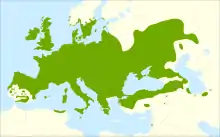 | |
| Distribution map | |
| Synonyms[2] | |
|
List
| |
The fruits are used to make sloe gin in Britain and patxaran in Basque Country. The wood is used to make walking sticks, including the Irish shillelagh.
Description
Prunus spinosa is a large deciduous shrub or small tree growing to 5 metres (16 feet) tall, with blackish bark and dense, stiff, spiny branches. The leaves are oval, 2–4.5 centimetres (3⁄4–1+3⁄4 inches) long and 1.2–2 cm (1⁄2–3⁄4 in) broad, with a serrated margin. The flowers are about 1.5 cm (1⁄2 in) in diameter, with five creamy-white petals; they are produced shortly before the leaves in early spring,[3] and are hermaphroditic, and insect-pollinated. The fruit, called a "sloe", is a drupe 10–12 millimetres (3⁄8–1⁄2 in) in diameter, black with a purple-blue waxy bloom, ripening in autumn and traditionally harvested – at least in the UK – in October or November, after the first frosts. Sloes are thin-fleshed, with a very strongly astringent flavour when fresh.[4]
Blackthorn usually grows as a bush but can grow to become a tree to a height of 6 m. Its branches usually grow forming a tangle.[5][6]
Prunus spinosa is frequently confused with the related P. cerasifera (cherry plum), particularly in early spring when the latter starts flowering somewhat earlier than P. spinosa. They can be distinguished by flower colour, pure white in P. spinosa, creamy white in P. cerasifera. In addition, the sepals are bent backwards in P. cerasifera, but not in P. spinosa.[7] They can be distinguished in winter by the shrubbier habit with stiffer, wider-angled branches of P. spinosa; in summer by the relatively narrower leaves of P. spinosa, more than twice as long as broad;[4][8] and in autumn by the colour of the fruit skin purplish black in P. spinosa and yellow or red in P. cerasifera.[9]: 207
Prunus spinosa has a tetraploid (2n=4x=32) set of chromosomes.[10]
Like many other fruits with pits, the pit of the sloe contains trace amounts of hydrogen cyanide.[11]
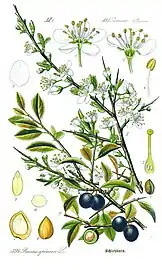 Illustration by Otto Wilhelm Thomé (1885)
Illustration by Otto Wilhelm Thomé (1885)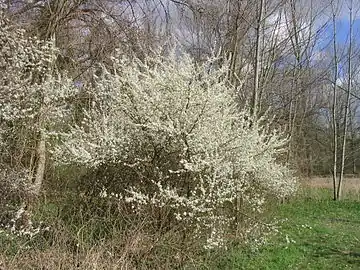 Plant in flower in early spring
Plant in flower in early spring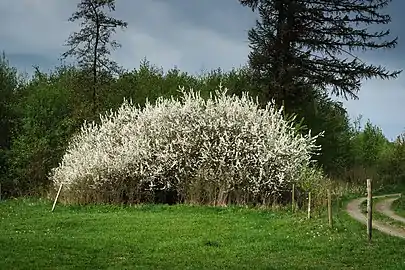 Blackthorn shrub in the Vogelsberg
Blackthorn shrub in the Vogelsberg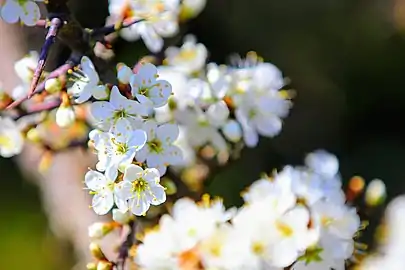 Close-up of flowers
Close-up of flowers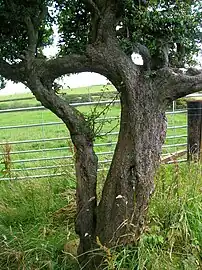 (Presumably grafted) Husband and wife tree
(Presumably grafted) Husband and wife tree
Etymology
The specific name spinosa is a Latin term indicating the pointed and thornlike spur shoots characteristic of this species. The common name "blackthorn" is due to the thorny nature of the shrub, and possibly its very dark bark: it has a much darker bark than the white-thorn (hawthorn), to which it is contrasted.[12]
The word commonly used for the fruit, "sloe", comes from Old English slāh, cognate with Old High German slēha, slēwa, and Modern German Schlehe.[13] Other cognate forms are Frisian and Middle Low German[lower-alpha 1] slē, Middle Dutch slee, slie, sleeu; Modern Dutch slee; Modern Low German slee/slē, slī;[13][14] Danish slåen.[13]
The names related to 'sloe' come from the common Germanic root slaihwō. Compare Old Slavic, Bulgarian, Macedonian, Ukrainian and Russian слива (sliva, Ukr. slyva),[14][13] West Slavic / Polish śliwa; plum of any species, including sloe śliwa tarnina—root present in other Slavic languages, e.g. Bosnian, Croatian, Montenegrin and Serbian šljiva / шљива.
Distribution and habitat
The species is native to Europe, western Asia, and locally in northwest Africa.[15][4] It is also locally naturalized in Tasmania and eastern North America.[15]
Ecology

The foliage is sometimes eaten by the larvae of Lepidoptera, including the small eggar moth, emperor moth, willow beauty, white-pinion spotted, common emerald, November moth, pale November moth, mottled pug, green pug, brimstone moth, feathered thorn, brown-tail, yellow-tail, short-cloaked moth, lesser yellow underwing, lesser broad-bordered yellow underwing, double square-spot, black hairstreak, brown hairstreak, hawthorn moth (Scythropia crataegella) and the case-bearer moth Coleophora anatipennella. Dead blackthorn wood provides food for the caterpillars of the concealer moth Esperia oliviella.
Uses

The shrub, with its long, sharp thorns, is traditionally used in Britain and other parts of northern Europe to make a cattle-proof hedge.[16]
The fruit is similar to a small damson or plum, suitable for preserves, but rather tart and astringent for eating, unless it is picked after the first few days of autumn frost. This effect can be reproduced by freezing harvested sloes.[17]
Since the plant is hardy, and grows in a wide range of conditions, it is used as a rootstock for many other species of plum, as well as some other fruit species.
Flavor
The juice is used in the manufacture of fake port wine, and used as an adulterant to impart roughness to genuine port, into the 20th century.[18][19][20] In rural Britain a liqueur, sloe gin, is made by infusing gin with sloes and sugar. Vodka can also be infused with sloes.[21] Similarly, in northern Greece they make a blackthorn liqueur by infusing tsipouro with the fruit and adding sugar.
In Navarre, Spain, a popular liqueur called pacharán is made with sloes. In France a liqueur called épine or épinette or troussepinette is made from the young shoots in spring rather than from fruits in autumn. In Italy, the infusion of spirit with the fruits and sugar produces a liqueur called bargnolino (or sometimes prunella). In France, eau de vie de prunelle[s] is distilled from fermented sloes in regions such as the Alsace[lower-alpha 2] and vin d'épine is an infusion of early shoots of blackthorn macerated with sugar in wine.[24][25] Wine made from fermented sloes is made in Britain, and in Germany and other central European countries. It is also sometimes used in the brewing of lambic beer in Belgium.
Food
Sloes can also be made into jam, chutney,[21] and used in fruit pies. Sloes preserved in vinegar are similar in taste to Japanese umeboshi. The juice of the fruits dyes linen a reddish colour that washes out to a durable pale blue.[16]
The leaves resemble tea leaves, and were used as an adulterant of tea.[19][26]
The fruit stones have been found in Swiss lake dwellings.[19] Early human use of sloes as food is evidenced in the case of a 5,300-year-old human mummy (nick-named Ötzi), discovered in the Ötztal Alps along the Austrian-Italian border in 1991: a sloe was found near the remains, evidently with the intent to eat it before the man died.[27][28]
Wood
Blackthorn makes an excellent fire wood that burns slowly with a good heat and little smoke.[29] The wood takes a fine polish and is used for tool handles and canes.[26] Straight blackthorn stems have traditionally been made into walking sticks or clubs (known in Ireland as a shillelagh).[30] In the British Army, blackthorn sticks are carried by commissioned officers of the Royal Irish Regiment; this is a tradition also in Irish regiments in some Commonwealth countries.
Inks
Rashi, a Talmudist and Tanakh commentator of the High Middle Ages, writes that the sap (or gum) of P. spinosa (which he refers to as the prunellier) was used as an ingredient in the making of some inks used for manuscripts.[31]
A "sloe-thorn worm" used as fishing bait is mentioned in the 15th-century work, The Treatyse of Fishing with an Angle.[32]
Culture
In Middle English, slō has been used to denote something of trifling value.[33][14]
The expression "sloe-eyed" for a person with dark eyes comes from the fruit, and is first attested in A. J. Wilson's 1867 novel Vashti.[34]
The flowering of the blackthorn may have been associated with the ancient Celtic celebration of Imbolc, traditionally celebrated on February 1 in Ireland, Scotland and the Isle of Man.[35]
The name of the dark-coloured cloth prunella was derived from the French word prunelle, meaning sloe.[36]
Notes
References
- Rhodes, L.; Maxted, N. (2016). "Prunus spinosa". IUCN Red List of Threatened Species. 2016: e.T172194A19400568. doi:10.2305/IUCN.UK.2016-3.RLTS.T172194A19400568.en. Retrieved 19 November 2021.
- "Prunus spinosa L." The Plant List: A Working List of All Plant Species (ver. 1.1 ed.). Retrieved 27 January 2014.
- Clapham, A.C.; Tutin, T.G.; Warburg, E.F. (1968). Excursion Flora of the British Isles. Cambridge, UK: Cambridge University Press. ISBN 0-521-04656-4.
- Rushforth 1999
- Kilbracken, J. (1995). Larousse Easy Way Guide to Trees. Larousse. ISBN 0-7523-0027X.
- "Prunus spinosa – Sloe, Blackthorn". PFAF Plant Database.
- "Blackthorn flowers". Tree Guide UK. Retrieved 9 February 2022.
- Vedel, H.; Lange, J. (1960). "Prunus spinosa". Trees and Bushes in Wood and Hedgerow. London, UK: Methuen. ISBN 0-413-30160-5.
- Stace, C.A. (2019). New Flora of the British Isles (4th ed.). Middlewood Green, Suffolk, U.K.: C. & M. Floristics. ISBN 978-1-5272-2630-2.
- Weinberger 1975, pp. 336–347.
- "Schlehen entkernen – ein Ding der Unmöglichkeit?" [Pitting sloes: An impossible thing?]. Garten Journal (in German). 12 November 2018. Retrieved November 17, 2021.
- Johns, Charles Alexander (1882). "The Blackthorn". The Forest Trees of Britain. Society for Promoting Christian Knowledge. pp. 103–112, esp. 105 – via Google Books.
- Whitney, William Dwight; Smith, Benjamin Eli, eds. (1906). "sloe". The Century Dictionary and Cyclopedia. Vol. 7 – via Google Books.
- "sloe". Oxford English Dictionary (1st ed.). Oxford University Press. 1933.
- "Prunus spinosa L." Plants of the World Online. Royal Botanic Grdens, Kew. Retrieved 21 March 2023.
- Coats 1992, Prunus.
-
Brown, Lynda (July 1994). "Damson time". House & Garden. Vol. 166. pp. 140–142, esp. 142 – via Google Books.
In former times people waited to pick the sloes until the first frost which makes the skins more permeable ... [A proprietor] which makes one of the best sloe gins, recommends freezing the fruit first.
- Gilman, D. C.; Peck, H. T.; Colby, F. M., eds. (1905). . New International Encyclopedia (1st ed.). New York: Dodd, Mead.
- Rines, George Edwin, ed. (1920). . Encyclopedia Americana.
-
White, Florence (1952). Good English Food, Local and Regional. p. 52 – via Google Books.
It appears that the cheaper kinds of so-called port consumed in this country are largely adulterated with sloe-juice.
- Kerri (10 Oct 2010). "Sloe gin and sloe chutney". Dinner Diary. Retrieved 31 August 2017.
- Alsace: produits du terroir et recettes traditionnelles. Albin Michel. 1998 – via Google Books.
- Sacré, Jacques (2004). Bon appétit, commissaire Maigret, ou Maigret et la table. Céfal. p. 9. ISBN 978-2-87130-148-6 – via Google Books.
- Pasty, Gilbert (1999). Glossaire des dialectes marchois et haut limousin de la Creuse. p. 155. ISBN 978-2-9513615-0-8 – via Google Books.
- Seaton, Jessica (2017). Gather Cook Feast: Recipes from land and water by the co-founder of Toast. Penguin UK. p. 123. ISBN 978-0-241-29885-5 – via Google Books.
- Beach, Chandler B., ed. (1914). . . Chicago: F. E. Compton and Co.
- Ghose, Tia (8 November 2012). "Mummy melodrama: Top 9 secrets about Ötzi the Iceman". LiveScience. Retrieved 10 November 2012. (to locate, click ahead to part 7)
- "Ötzi the Iceman". The Copper Age. Museo Archeologico dell'Alto Adige. 2016. Retrieved 2019-07-19.
- The Burning Properties of Wood (PDF) (Report). The Scout Association. 1999. Archived from the original (PDF) on 2012-12-23.
- Chouinard, Maxime (2007). The stick is king: The Shillelagh Bata or the rediscovery of a living Irish martial tradition (PDF) (Report). Archived (PDF) from the original on 1 January 2012. Retrieved 17 November 2022.
- Talmud Bavli, Tractate Shabbat 23a
- Berners, Dame Juliana (attributed to) (3 August 2006) [c. 1420]. The Treatyse of Fishing with an Angle. Waking Lion Press. ISBN 978-1-60096-446-6.
- Lewis, Robert E., ed. (1988). "slō". Middle English Dictionary. University of Michigan Press. p. 1063. ISBN 0-472-01198-7 – via Google Books.
- "sloe-eyed". Oxford English Dictionary (Online ed.). Oxford University Press. (Subscription or participating institution membership required.)
- Aveni, Anthony F. (2004). The Book of the Year: A brief history of our seasonal holidays. Oxford University Press. p. 38. ISBN 0-19-517154-3.
- "prunella". Merriam-Webster. Retrieved 2021-05-22 – via merriam-webster.com.
Bibliography
- Coats, Alice M. (1992) [1964]. "Prunus". Garden Shrubs and Their Histories. New York, NY: Simon & Schuster. ISBN 0-671-74733-9.
- Weinberger, J.H. (1975). "Plums". In Janick, J.; Moore, J.N. (eds.). Advances in Fruit Breeding. West Lafayette, IN: Purdue University Press. pp. 336–347. ISBN 0-911198-36-9.
External links
- "Prunus spinosa". Plants for a Future.
- "Sloe recipes". Cookipedia.
